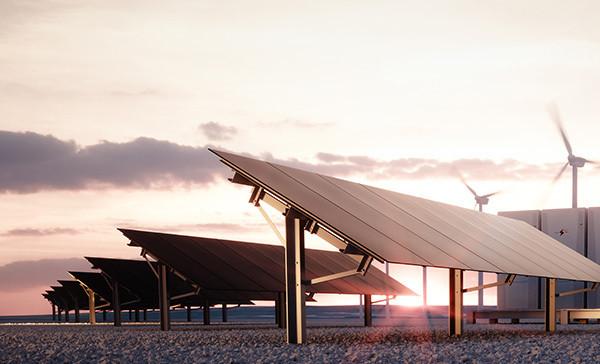Appearing in the new round of battle investment list of Fujian Jinshi Energy Co., Ltd. (hereinafter referred to as "Jinshi Energy"), BYD's low-key shareholding posture is quite calm, but the "ambition" of multi-line attack cannot be underestimated.
According to public information, Jinshi Energy has recently undergone industrial and commercial changes, adding a number of shareholders including BYD, Huijin Venture Capital, Xiamen Guoxing Investment, etc., the registered capital has increased to about 215 million yuan, and the company's business scope has been expanded to semiconductor device special equipment manufacturing, photovoltaic equipment and component manufacturing, photovoltaic power generation equipment leasing and other fields.
On the one hand, the heterogeneous knot "upstart", on the other hand, the "old Ji" in the optical storage industry, the enterprise with the "new energy gene" has borrowed capital and grown wings at the same time, the traditional giants have also completed the layout of industrial transformation through investment, self-research and other actions - a new energy ecological map of "you have me, I have you" has surfaced.
Equity bond forms the "golden stone alliance"
The industry track and technology accumulation are undoubtedly the most important attraction points for BYD to invest in Jinshi Energy.
According to the official website, Jinshi Energy is mainly engaged in the research and development, manufacturing, sales and comprehensive services of HDT high-efficiency solar cell industrialization production equipment and the complete set of production lines "turnkey project", involving solar cells, heterojunction, amorphous silicon layer, amorphous silicon film and other technical fields.
Looking back on the company's development history, in 2005, Jinshi Energy entered the research and development of silicon-based thin-film solar cell technology and equipment; in 2010, it became the first domestic manufacturer of thin-film solar cell equipment sales of more than 1GW; in 2011, the small-scale R&D experimental line of high-efficiency HDT heterojunction solar cell project was successfully built; in 2014, the second-generation HDT production line was successfully built, and the efficiency exceeded 21.5%; in 2016, the third-generation production line of high-efficiency HDT heterojunction was officially put into production. It has become China's first high-efficiency solar cell production line with independent intellectual property rights at the level of 100 MW; in 2020, the 6th generation of equipment will be launched, and the stand-alone production capacity will reach 350MW.
For more than ten years, it has accumulated a deep "patent pool" for Jinshi Energy. It is reported that the company has applied for more than 150 patents related to high-efficiency solar cells, of which the higher market value includes "solar cells and their gate electrode production methods".
R & D results are applied to the production end, starting in 2020, Kingstone Energy will gradually introduce the microcrystalline process into the independent research and development of PECVD equipment, on the basis of having a mature HJT cell microcrystalline process, launched HJT cell double-sided microcrystalline PECVD equipment. Compared with the peer N-layer single-sided microcrystalline devices, the conversion efficiency of the microcrystalline doped layer HJT battery can be 0.5% higher, and it is feasible for large-scale mass production. As a result, Jinshi Energy became the first enterprise in China to have double-sided microcrystallization technology for HJT batteries and launch related equipment.
On the other hand, BYD, which lists secondary batteries and photovoltaics as one of the four major business sectors, has also used equity as a link to expand its boundaries in the field of new energy.
In September 2020, BYD took a stake in photovoltaic company Canadian Solar Power Group. The latter is mainly engaged in silicon ingots, wafers, solar cells, solar modules and solar application products, etc., helping BYD to go further in the solar photovoltaic module and system solutions business. This joint effort with Jinshi Energy is regarded as another measure for BYD to lay out the next generation of photovoltaic cell technology.
Multi-line attack to jointly build a new energy ecology
It is a car company, and not only a car company. Today's BYD is more like a company driven by the "four wheels" of automobiles, electronics, new energy and rail transit.
"Our dream is to build a zero-carbon, zero-emission ecological environment system through technological innovation, and make the environment greener and more environmentally friendly." Wang Chuanfu, chairman and president of BYD, once described such a new picture to the outside world: from solar power generation to vehicle manufacturing to energy storage, building a complete closed loop.
How to make this "dream" shine into reality? In 2008, BYD Solar Was established; in December of the same year, the BYD Solar Energy Project, with an investment of 500 million yuan and mainly producing polysilicon and solar cells, was launched; in 2010, BYD set up its own module team to independently develop silicone module products and realize applications in the Brazilian market, completing the construction of the world's largest silicone double-glass module photovoltaic project.
BYD Solar also proudly "sunburned" on its official website: using liquid silicone as the encapsulation material, using glass as the backplane material, and using a highly waterproof polyisobutene rubber seal around the module - this unique combination of materials gives the company's double glass modules excellent moisture barrier ability, excellent UV resistance and weather resistance.
To the vast and subtle. In the past 10 years, Wang Chuanfu's attempts at "cross-border" have continuously expanded BYD's extension. "BYD has a technical 'fish pond', which has a variety of technologies, and when the market needs it, we will fish one out." Chips, electric vehicles, rail transit, etc. are all big fish in the 'fish pond'. Nowadays, there is more "one" photovoltaic in this "fish pond". This means that Wang Chuanfu personally "dismantled" the vertical integration model he created with his own hands, trying to make every business sector exert light and heat.
At the same time, the vast track of new energy has also attracted giants such as Huawei to "race".
For these giants who seek "multi-faceted development", new energy has no boundaries and limits, only interconnection and infinite possibilities.
